If you have strolled along Cemetery Road at night and looked up at the Pilgrim Monument, you may have noticed, just underneath it, a well-lit studio and a painter working inside. That would be Simie Maryles, who has been painting Provincetown since summer 1974 when she arrived.
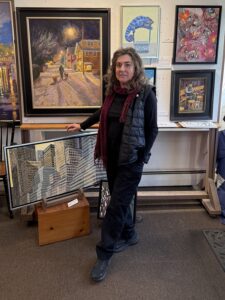
Maryles started as a pastel portrait artist in the old Whaler’s Wharf, where summer people flocked to have their likenesses painted. Spots for artists at the Wharf were coveted, and Maryles had to get in line and wait. It wasn’t until one of the artists had a heart attack dancing at the A-House that Maryles got her chance.
She struggled at the beginning. “You could have 50 people watching,” says Maryles. “I couldn’t stop my hand from shaking.” There were about 30 other portrait artists, and you had to hustle people into your seat while the crowd observed. “It was a terrifying experience, but I’m very tenacious.”
She went home to New York to sharpen her skills, but when she came back the following summer Whaler’s Wharf wouldn’t have her. She and two friends rented space in the alley next to the current Cock N Bull leather shop. She was still making portraits — but outside the assembly line at the wharf.
A friend of Maryles, painter John Arana, built a foldable shop for them that collapsed on hinges into a five-foot triangle. The trio would set up the shop in the morning with three artist chairs and easels, with a chair for each sitter. They worked long days. They would fold up the shop 10 minutes before 11 p.m. and race to make last call at the Cellar Bar.
Someone from the Lizardi-Harp Gallery in Pasadena, Calif. saw Maryles’s pastel work and the gallery began representing her in the 1980s. She says her shows over a decade there often sold out.
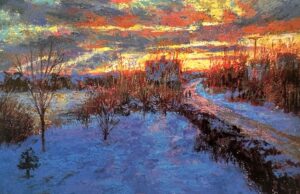
In spite of that success, she questioned her talent. When she went to California to see her shows, she’d walk in with her hands over her eyes. “You see your work all up, but you have to be able to see it objectively,” Maryles says. The experience gave her insomnia. At the end of the 1980s when the economy faltered, the gallery closed.
Maryles sought representation on Cape Cod, where a gallerist suggested that she shift to oil paintings. “Oil is the empress,” she says. She obliged and never returned to pastels.
Maryles opened her own Provincetown gallery at 435 Commercial St. in 1998 and has run it ever since. Her gallery stays open late at night, one of the few that still does. But the building is set to be sold in March. Instead of looking for another space to rent, Maryles decided to buy the building at 378 Commercial — the former Wired Puppy coffee shop. She needs to be out of her current space by Jan. 31 and expects to be open in the new one by early April.
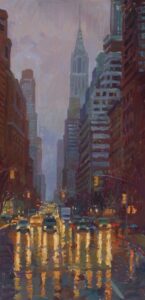
Maryles was known for her pastel process: taking marble dust to watercolor paper to create a rough surface for her pictures. In one plein-air work of a winter scene in Truro we see her marks energetically cover the whole sheet; the grittiness of the paper catches the pastel and creates texture for her brightly colored marks.
Another work in pastel on watercolor paper is of Truro’s Corn Hill in spring, which was included in the book Trees, Flowers & Foliage by Patricia Seligman. In a work on rag board, we see the same Corn Hill landscape with the artist highlighting the shifting colors of fall. Evergreen and spruce hide in the shadows, while red shrubs in the foreground brighten either side of a meandering stream.
In her oil paintings, she focuses not only on the scene but on the design of the picture — often flipping the canvas upside down to make sure the design is strong. She uses a slim and rounded Winsor Newton watercolor brush, saying that the shape reminds her of the pastel sticks she left behind.
In one of Maryles’s new oil paintings, Hushed and Still, a figure with two dogs approaches the warm light of a Commercial Street storefront — her gallery — in a snowstorm. The choppy marks are reminiscent of her work with pastels, while the loneliness of the winter street scene hearkens back to works by Provincetown painter Nancy Whorf.
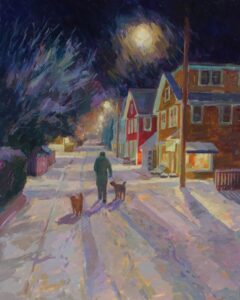
In The Night Whispers, Maryles has covered every inch of the canvas. Here we see her mastery of tonal qualities — street and sky mirror one another, one angular and the other soft-edged.
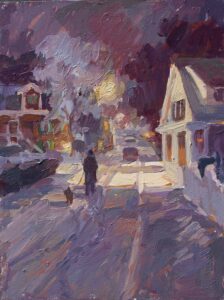
In Sparkling on the Bay, Maryles uses partially dried oil as an underpainting, which shows through in magenta streaks in the sky. The town is lit up at early evening in warm tones. Lavender oils for houses and rooftops complement the soft flax and amber light glowing in windows.
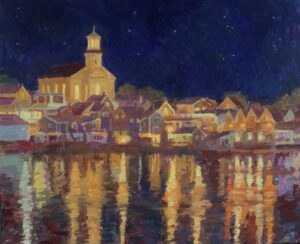
Maryles dropped out of college at SUNY Binghamton and found her way to Paris, where she studied at the École des Beaux-Arts. Eventually heading back to New York in the ’70s, she painted at the Art Students League under Ray Kinsler, colorist Vincent Malta, and David Leffel, a tonal chiaroscuro painter. The classes were set up as an atelier where instructors roamed and students were accountable to themselves. Leffel guided her the most with his sense of tonal relationships.
Maryles grew up on Long Island, N.Y. flipping through art books on Dürer and Vermeer at her local public library. She would sit on her family’s patio and watch the sun go down behind a hedge, studying the colors as they shifted from green to indigo to black.
When she was six years old, Maryles got into an argument with her brother, who told her he was going to draw a picture of her nude. She returned the favor. His was a stick figure portrait, while hers was more developed, getting her in deep trouble but also leading her father to admit, “We have an artist in the house.”



